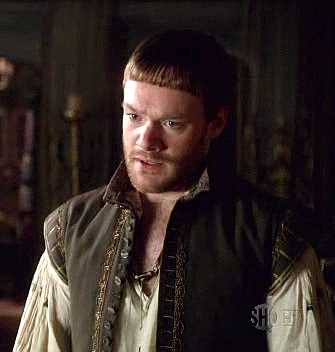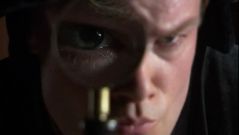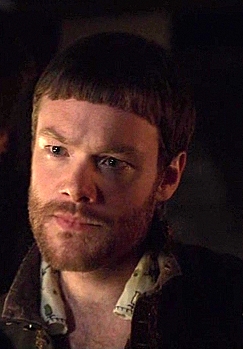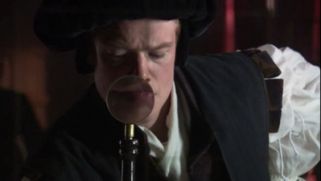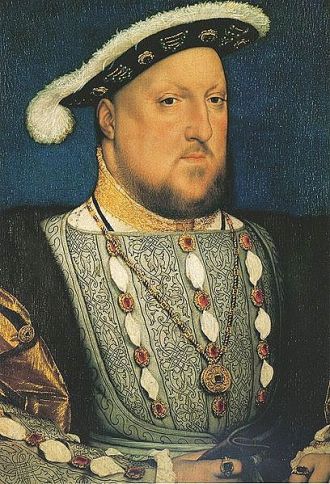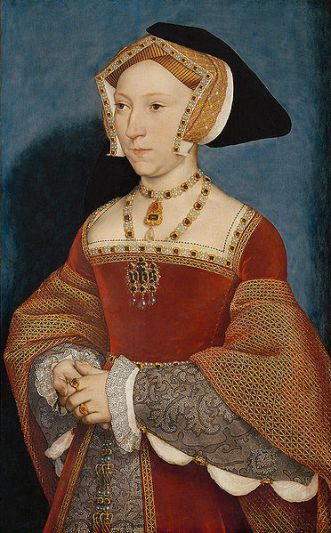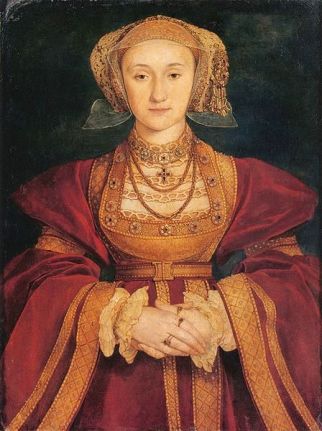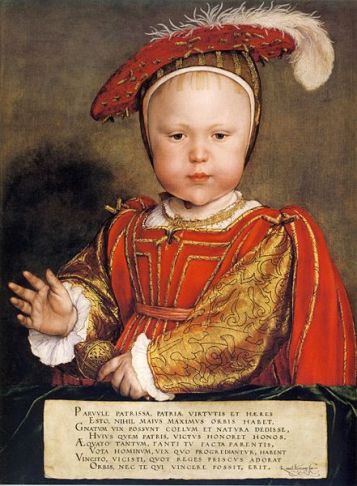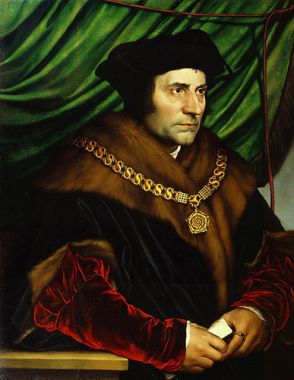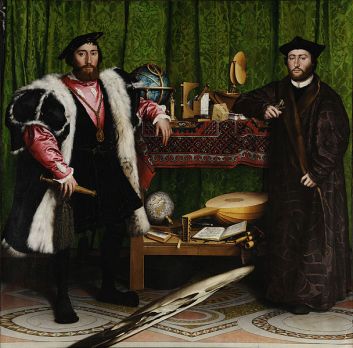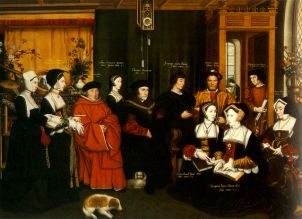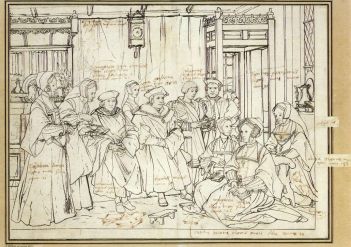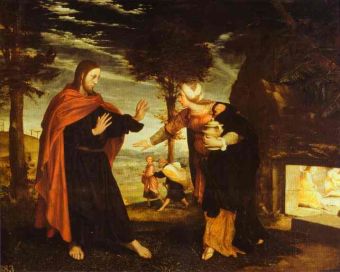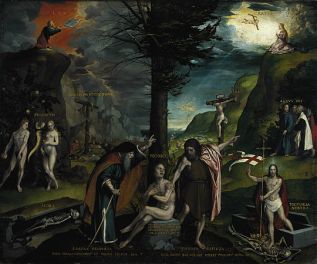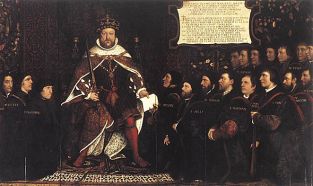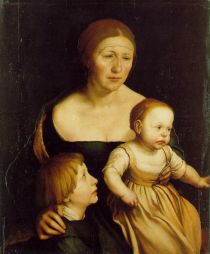Hans Holbein
Revision as of 15:50, 13 November 2020 by Travis (talk | contribs) (Created page with "<div class="WPC-editableContent"><font size="4"><b>Hans Holbein</b> the Younger <font color="#808080">as played by </font>Peter Gaynor<br/></font><div align="right"><div a...")
Hans Holbein the Younger as played by Peter Gaynor
UNFORGETTABLE CHARACTER QUOTES
DEFINING EPISODES | MEMORABLE SCENES
*Click here for "The Works of Hans Holbein" - a more extensive page
PHOTOS
Some of Holbein's most famous works:
Court Portrait Artist & Designer
| | ||
| born 1497 - died November 29, 1543 Character's backstory: Son of Hans Holbein the Elder, Hans Holbein the Younger was arguably one of the greatest portrait artists of his time. Born in Augsburg, Germany, Holbein was taught his skill by his father and gained experience painting altar pieces and carving woodcuts. In 1515, the Holbiens moved to Basel, Switzerland a growing community of artists and humanist scholars. By 1525, Basel had become a difficult place for an aritist like Holbein to work. The religious and political influence of the Luthereans had by then took over, and production of nonreligious artwork was outlawed. Religious artwork, for that matter, was austere and very few projects would be commissioned by the new Lutheran society. With a letter of introduction from his patron and mentor Erasmus, Holbein traveled to England for the first time in 1526. Holbein went on to paint many in the court of King Henry VIII, including Thomas More, Anne Boleyn, Jane Seymour, and perhaps most infamously, Anne of Cleves. Henry charged Holbein to create as accurate a portrait of Anne as possible, and in all likelihood, Holbein did his best not to flatter the German princess (as was the common practice of the day). However, Henry attacked the portrait after his marriage for being too complimenting to Anne (not because, as was probably the case, he needed an excuse to rid himself of his new wife). In all likelihood, many historians today believe Holbein's depiction was accurate. Despite the criticism, Holbein continued to create portraitures for Henry, and it was while painting a portrait of the King that Holbein contracted what was likely the plague and died. Patrons: Thomas More (1526-1528), Anne Boleyn (1532 - 1536), Thomas Cromwell (1534 - 1540) and King Henry VIII Position: Court portrait artist (from 1536) Personality type: With an eye for detail, Holbein was noted for his ability to catch the personality of his subjects in his artwork. Very observant, and most likely an honest artist. Signature look: Endearing trait(s): Annoying trait(s):
| "the cameraman of Tudor history" ~ John North Matthew Parker (Anne Boleyn's chaplain and later made Archbishop by Elizabeth I) said that Hans Holbein's portraits were "delineated and expressed to the resemblance of life" "Holbein's manner have I ever imitated, and hold it for the best" ~ Nicholas Hilliard 16th century miniaturist artist 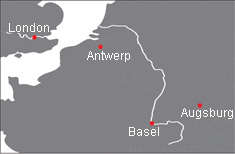 First Period: Basel (1515-1526) Second Period: England (1526-1528) Third Period: Basel (1528-1532) Fourth Period: England (1532-1543) Click EasyEdit to update this page! (Don't see the EasyEdit button above? <a href="../#signin" target="_self">Sign in</a> or <a href="../accountnew" target="_self">Sign up</a>.) | |
CHARACTER CONNECTIONSFamily members: Hans Holbein the Elder: Father Ambrosius Holbein: Brother Elsbeth Binzenstock: Wife Phillip Holbein: Son Catherine Holbein: Daughter Romance(s): Magdalena Offenburg: was Holbein's model for such works as "Venus and Amour" and "Lais of Corinth", she may also have been his mistress for a time Friends: Desiderius Erasmus Sir Thomas More King Henry VIII of England Enemies: German Lutherans | Portrait Techniques Holbein always made highly detailed pencil drawings of his portrait subjects, often supplemented with ink and colored chalk. The drawings emphasize facial detail and usually did not include the hands; clothing was only indicated schematically. The outlines of these drawings were then transferred onto the support for the final painting using tiny holes in the paper through which powdered charcoal was transmitted; in later years Holbein used a kind of carbon paper. The final paintings thus had the same scale as the original drawings. Although the drawings were made as studies for paintings, they stand on their own as independent, finely wrought works of art. He painted a few, superb, portrait miniatures, having been taught the art by Lucas Horenbout, a Flemish illuminator who was also a court artist of Henry. Horenbout painted Holbein in perhaps his best miniature, and the best portrait we have of Holbein, who never made a self portrait. Modern day artist David Hockney has speculated in the <a class="external" href="http://en.wikipedia.org/wiki/Hockney-Falco_thesis" rel="nofollow" target="_blank" title="Hockney-Falco thesis">Hockney-Falco thesis</a> that Holbein used a concave mirror to project an image of the subject onto the drawing surface. The image was then traced. However this thesis has not met with general acceptance from art historians. |
| LINKS: Series of videos focusing on Hans Holbein the Younger's commissions for Henry VIII:
|
LITERATURE:
|
UNFORGETTABLE CHARACTER QUOTES
|
DEFINING EPISODES | MEMORABLE SCENES
Ursula Misseldon
|
*Click here for "The Works of Hans Holbein" - a more extensive page
PHOTOS
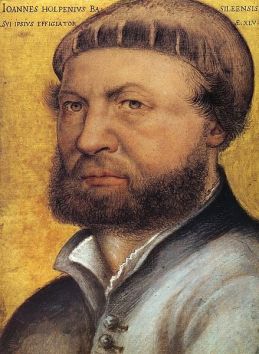 | |
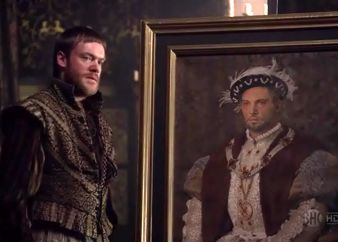 | 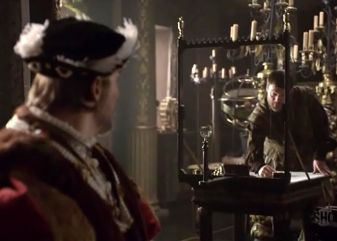 |
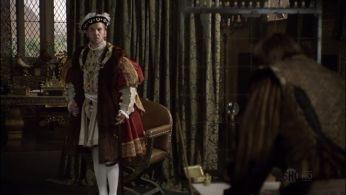 | 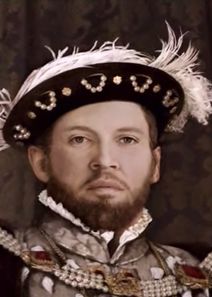 |
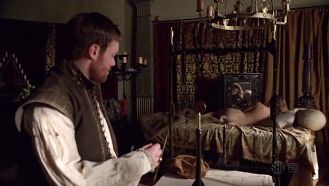 Holbein paints Lady Ursula Misseldon | 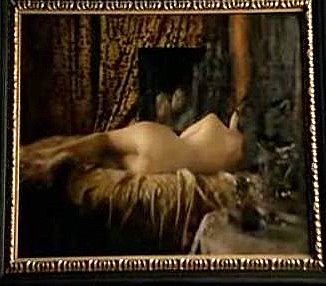 Although shown as a work of Holbein, this piece in reality is called "Venus at her Mirror (The Rokeby Venus), 1650 and painted by <a class="external" href="http://commons.wikimedia.org/wiki/Diego_Vel%C3%A1zquez" rel="nofollow" target="_blank" title="Diego Velázquez">Diego Velázquez</a>. National Gallery, London. See: The Tudors Inspirations |
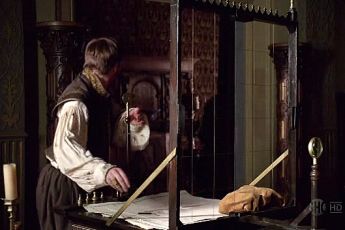 | 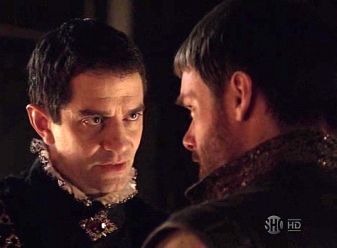 |
| | <embed height="326" src="http://widget.wetpaintserv.us/wiki/thetudorswiki/widget/genericvideo/c71f42be7a9609b36c99106a6e93e151649b5656" type="application/x-shockwave-flash" width="326" wmode="transparent"/> |
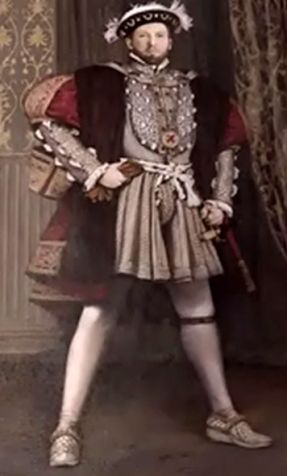 | 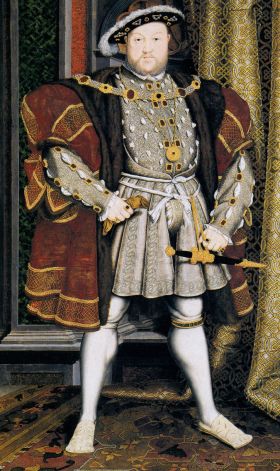 after Holbein |
<embed flashvars="transition=Fade&site=http://tudorswiki.sho.com&imageServer=http://image.wikifoundry.com&albumId=115840" height="400" src="http://widget.wetpaintserv.us/wiki/thetudorswiki/widget/unknown/60b2ed63f900f7756c5d25394987cb7525197e33" type="application/x-shockwave-flash" width="400" wmode="transparent"/> Slideshow of Holbein's drawings of Court figures |
| <embed allowfullscreen="true" height="376" src="http://widget.wetpaintserv.us/wiki/thetudorswiki/widget/youtubevideo/db74b152af02f3748b7facac6dbbb31b3568698a" type="application/x-shockwave-flash" width="467" wmode="transparent"/> |
Some of Holbein's most famous works:
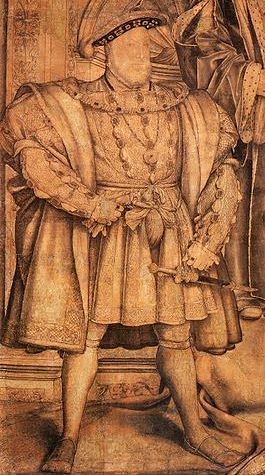 This is the only full length portrait by Hans Holbein himself which remains. It is a section of a preparatory drawing for a mural at Westminster Hall that included life-sized portraits of Jane Seymour and Henry's parents. The mural was destroyed by fire in 1698. All other portraits of Henry in this famous pose are copies by other artists. At this time, the pose was unusual, since standing with legs apart, though heroic, had been considered impolite; but it was later imitated, for example in portraits of Henry's son and heir Edward VI | c.1536 Based on the drawing to the left located in the Thyssen-Bornemisza Museum in Madrid, Spain |
| c.1536 Jane Seymour at the Kunsthistorisches Museum, Vienna | 1538 Anne of Cleves Holbein's infamous portrait which led Henry VIII to fall in love with her, only to be disappointed after they meet that he "liked her not" Located in Louvre Museum, Paris |
| c.1538 Portrait of Prince Edward Tudor, Prince of Wales. In the National Art Gallery in Washington The text translated into English reads: "Little one, emulate thy father and be the heir of his virtue; the world contains nothing greater. Heaven and earth could scarcely produce a son whose glory would surpass that of such a father. Do thou but equal the deeds of thy parent and men can ask no more. Shouldst thou surpass him, thou hast outstript all, nor shall any surpass thee in ages to come. By Sir Richard Morison." | 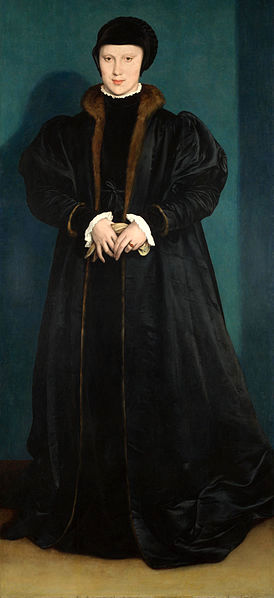 1538 Christina of Denmark in the National Gallery, London Holbein painted this portrait ofthe young widowed Duchess of Milan, for Henry who was considering her as a possible wife. |
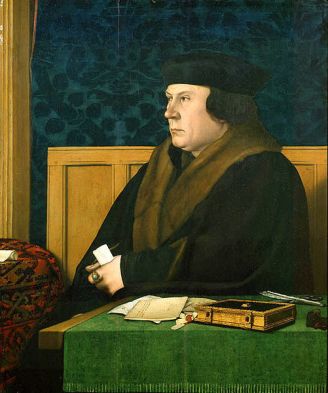 c.1532/3 Thomas Cromwell The Frick Collection, New York City | Sir Thomas More in the Frick Collection, New York City |
For an up-close view of this famous painting check out : <a class="external" href="http://www.googleartproject.com/museums/nationalgallery/the-ambassadors" rel="nofollow" target="_blank" title="The Google art project">The Google art project</a> | About "The Ambassadors" by Hans Holbein and the detail: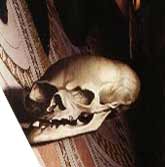 As well as being a double portrait, the painting contains a still life of several symbolic objects, the meaning of which is the cause of much debate such as the skewed (anamorphic) skull at the bottom of the painting - shown to the left . The viewer must approach the painting nearly from the side to see the form morph into a completely accurate rendering of a human skull. As well as being a double portrait, the painting contains a still life of several symbolic objects, the meaning of which is the cause of much debate such as the skewed (anamorphic) skull at the bottom of the painting - shown to the left . The viewer must approach the painting nearly from the side to see the form morph into a completely accurate rendering of a human skull.One possibility is that this painting represents three levels: - the heavens (as portrayed by the astrolabe and other objects on the upper shelf), - the living world (as evidenced by books and a musical instrument on the lower shelf), - and death (signified by the skull). The upper left corner, is a crucifix with Jesus on the cross behind the curtain which may represent the diplomatic efforts to achieve reconciliation between Catholics and Protestants |
| "The Family of Sir Thomas More" 1527 | |
| | "Allegory of the Old and New Testaments" |
"Henry VIII and the Barber Surgeons" 1543 | The Family of Hans Holbein His Wife, Elsabeth, son Philip and daughter Catherine |
